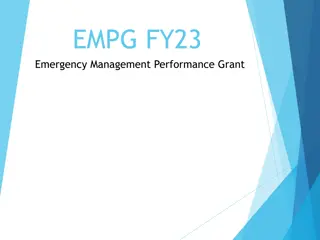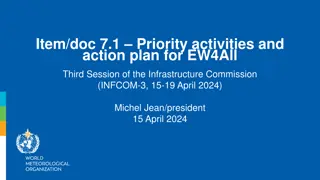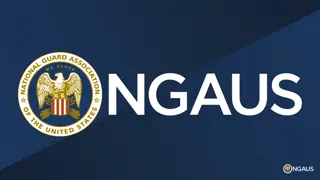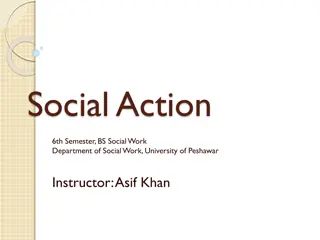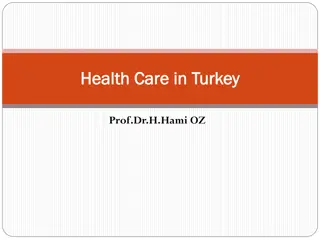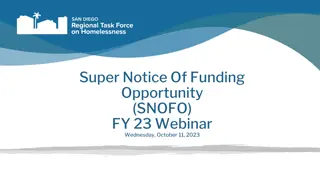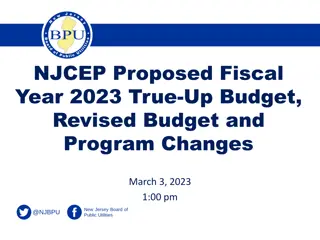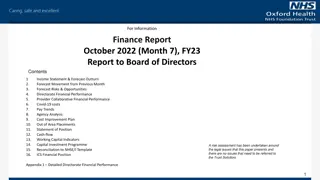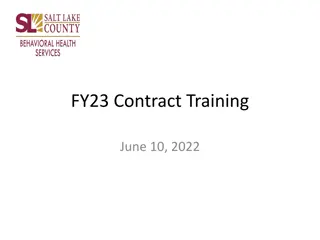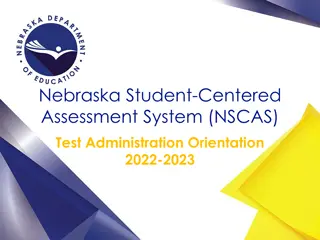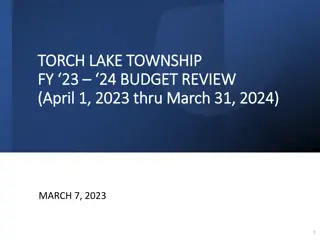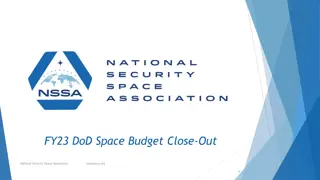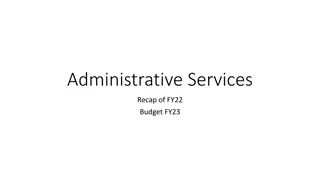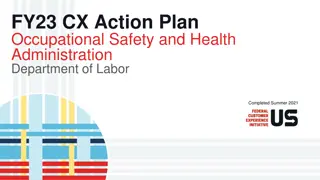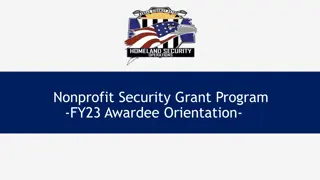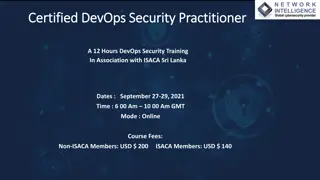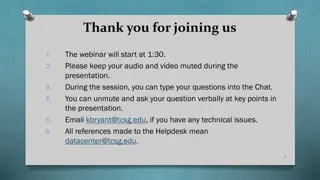FY23 CX Action Plan for Social Security Administration
The FY23 CX action plan for the Social Security Administration focuses on improving customer service and customer experience across all service channels. The plan outlines initiatives to enhance feedback management, address operational challenges, improve document handling, obtain timely customer feedback, and enhance authentication solutions for online services.
Download Presentation

Please find below an Image/Link to download the presentation.
The content on the website is provided AS IS for your information and personal use only. It may not be sold, licensed, or shared on other websites without obtaining consent from the author.If you encounter any issues during the download, it is possible that the publisher has removed the file from their server.
You are allowed to download the files provided on this website for personal or commercial use, subject to the condition that they are used lawfully. All files are the property of their respective owners.
The content on the website is provided AS IS for your information and personal use only. It may not be sold, licensed, or shared on other websites without obtaining consent from the author.
E N D
Presentation Transcript
FY23 CX Action Plan Social Security Administration
FY21 Capacity Assessment Reflection Summary What we are proud of this year: To ensure the safety of the public and our employees, we are proud of the rapid shift we made during the pandemic to provide services remotely to our customers during a challenging time. We serve the public at critical times in their lives, such as the birth or adoption of a child, at the onset of a disability, when preparing for retirement, or dealing with the death of a loved one. Our top priority is to improve customer service and customer experience (CX) across all three-service channels: in-person (when available), on the telephone, and online. Our Chief Business Officer (CBO), the lead executive dedicated to improving the customer experience has developed an agency CX management vision that outlines several customer experience initiatives. We recently procured and began implementing an enterprise Customer Feedback Management solution from Medallia, that captures real time customer feedback from all service delivery channels. Where we need to do better: During the pandemic, we quickly developed a solution that used two of our current telephone platforms to allow our 800 number agents to continue serving our customers while working remotely. Because we had to spread calls across two platforms, we could not use some of our pre-pandemic 800 Number functionality, like providing estimated wait times and the ability for customers to request a call back, along with the ability for callers to provide feedback about their experience via a post-call survey. In addition, this operational adjustment has affected our ability to track some management information (MI) data for performance on these two platforms. We are transitioning to a new, modern telephone platform that we expect to address these issues. We need to eliminate delays in receiving and handling documents. We are experiencing difficulties obtaining medical evidence needed to make disability decisions. We need to standardize and centralize our research to obtain timely customer feedback in order to drive faster business process changes. We need to implement more flexible authentication and identity proofing solutions to better identify our customers during their interactions with us and increase safe access to our suite of online services. 2
Adapting Service During a Global Pandemic Where we innovated As a High Impact Service Provider offering an array of services to the public and a large national footprint, the pandemic has driven service delivery innovation and flexible solutions for serving our customers. We made the following improvements or enhancements: Launched an online video options for hearings conducted in our Office of Hearings Operations and for State Protection and Advocacy grantees conducting payee-monitoring reviews. Enhanced our technology to support remote work capabilities. For example, we increased our systems bandwidth to support an increased volume of remote users, and implemented a solution using our current telephone platforms to enable our 800 Number agents to serve customers remotely. Digitized some paper processes and added online service options, like the Medicare Part B Supplemental Medical Coverage (Form CMS-40B) applications, which more than 300,000 seniors have used. Expanded the ability to sign and submit forms online; (i.e. SSA-455 Disability Update Report, SSA-1696 Appointment of Representative and CMS-40b Enrollment in Medicare). Implemented a mobile process for visitors to check in for a scheduled field office appointment from a personal mobile device. The new service also incorporates a COVID-19 screening page. Obtained laptops and cell phones for the DDSs to ensure continuity of the adjudication of initial and reconsideration level disability decisions. 3
HISP Equity Reflection Who is this provider intended to serve? For more than 85 years, we have provided income protection. We provide benefits to retirees, individuals with disabilities, and families that lose a wage-earner through the three programs we administer under the Social Security Act: the Old-Age and Survivors Insurance (OASI) program, the Disability Insurance (DI) program, and the Supplemental Security Income (SSI) program. Almost 90 percent of seniors over the age of 65 receive Social Security benefits; each month we pay benefits to more than 70 million eligible individuals. In addition to serving members of the public during major life events, we also provide Social Security number cards and track wages for those who pay into the trust fund. Are there barriers that people of color, people with disabilities, LGBTQ+ people, women, non-native English speakers, and others who have been historically underserved, marginalized, discriminated, and adversely affected by persistent poverty and inequality face with regard to this program or service? How might these individuals interact with your program differently? We are working to quantify the barriers faced by underserved communities in accessing our programs. Research shows that underserved communities face barriers that affect participation and eligibility in our programs, including, for example: technology and health care access, health care provisions, education, earnings, employment, criminal justice involvement, housing, internet access, savings, and banking. We have little information on how program-specific barriers may affect participation, eligibility, and service delivery apart from those external factors. Limitations on in-person services may pose a greater barrier for some individuals who lack stable housing, do not have reliable internet access, or have an insufficient understanding of program rules due to the complexity, as well as those who have mental health impairments and limited information provided in their native language. We have engaged with third-party organizations to help us better serve these individuals. 4 Where do we have a knowledge gap about individuals interactions with our service we need evidence to fill? The primary knowledge gap is data on who is in an underserved community. Our program data on race and ethnicity have several limitations, and we are working to both improve it and use as much as we can. Data that identify claimants and beneficiaries in other underserved communities (i.e., LGBTQ+, non-native English speakers, etc.) are even more scarce.
Our Service Commitments As our country rebounds from a pandemic that has changed how we engage in our communities, the need for our services and benefits are dire, particularly for people facing barriers to access. We are committed to identifying and addressing barriers that might prevent eligible individuals from participating in our programs. Below are a few of our efforts to identify and address such barriers: Serving people facing barriers: Improving outreach, equitable access to programs and in-office service Established nearly 650 liaisons in field offices to serve as points of contact for organizations who are committed to helping us reach people facing barriers to our services. We are providing each partner organization with training and resources to help them better assist their clients. Sent targeted outreach mailers to encourage OASI and DI beneficiaries who may also be eligible for SSI to apply. Specifically, 200,000 such mailers were released between December 2020 March 2021. We plan to send 1.2 million mailers between June 2021 and June 2022. Prioritized Medicare enrollments and SSI claims for those in need of Medicaid to ensure ongoing access to healthcare for seniors, individuals who have limited income and resources, and children with disabilities. Running paid digital advertisements in English and Spanish to promote SSI. Applying maximum flexibility when extending good cause provisions related to the timely filing of applications, as well as the submission of evidence, appeals, hearings, redeterminations, and continuing disability reviews. Organizing efforts to improve existing race and ethnicity data. By FY 2023, we expect to use the enhanced data to quantify disparities and barriers, and to expand publication of statistics and research that use program data on race and ethnicity. Working on publishing statistics by race and ethnicity on disability beneficiaries. By FY 2023, we expect to begin producing more precise estimates of disparities by race and ethnicity in the disability programs. Promoting existing policies that enable benefit continuation throughout the administrative appeals process. Offering the new Express Interview (EXI) option starting May 2021. EXIs are brief interviews, generally 5-7 minutes in length, which allow eligible individuals to apply for an original or replacement Social Security Number (SSN) card and submit necessary evidence in person. While this initiative is primarily intended to assist customers who need an SSN card, EXIs are also available for purposes of gathering evidence needed for processing claims and other workloads. 5
FY22-23 Commit to Action: Improve the customer experience by reducing the Average Speed of Answer on the National 800 Number What customer need will this action address? Our 800 Number handles over 33 million calls each year. Our customers want accurate, efficient, and reliable service every time they interact with us. Callers can conduct a variety of business transactions by speaking directly with an agent or through our 24-hour automated services, which include requesting benefit verification letters, ordering replacement Medicare cards, or obtaining claim status updates. Why is this a priority? Customers who call our National 800 Number often experience lengthy wait times to speak to an agent. In FY 2019, our Average Speed to Answer (ASA) peaked in October with our callers waiting an average of almost 40 minutes to speak with an agent. While we diligently worked to improve these service indicators in FYs 2020 and 2021, the COVID-19 pandemic slowed our progress (see data on slides 7 and 8). As of June 2021, the fiscal year-to-date ASA is 15 minutes, matching the FY 2021 target of 15 minutes. For the same period, the fiscal year-to-date Agent Busy Rate (ABR) is 0.3 percent, and currently below the FY 2021 target of 2.0 percent. We are highlighting our commitment to Improve the customer experience by reducing the Average Speed of Answer on the National 800 Number as an Agency Priority Goal in FYs 2022-2023. Who is responsible for this action happening? Deputy Commissioner for Operations 6
FY22-23 Commit to Action: Improve the customer experience by reducing the Average Speed of Answer on the National 800 Number What action(s) / deliverables / milestones will you take / hit between Oct. 1, 21 Sept. 30, 22? By the end of FY 2022, we expect to reduce average wait times to 12 minutes and handle 36 million calls. We also plan to reduce the ABR to 1 percent. These goals are subject to change based on our FY 2022 appropriation. Please see our FYs 2022-2023 Agency Priority Goal Action Plan for more details. We are implementing our Next Generation Telephony Project (NGTP) to improve our telephone service across the agency. NGTP will replace our three current telephone systems with a single platform to integrate modernized telecommunications technology. We expect the single platform phone system will operate more efficiently than our current platforms. NGTP will provide callers with additional information and options to improve their experience, including providing expected wait times and scheduled callbacks, which will reduce the wait time to speak with an agent. It will also include automated options for inquiries regarding Medicare replacement cards, 1099s, and claim status. Additionally, NGTP will help us to streamline and enhance our training for new hires, which will allow our employees to begin handling calls earlier. We have developed a robust program for measuring performance and communicating expectations, which NGTP will support. We plan to transition to the new system within the next year and then incorporate new features. What action(s) / deliverables / milestones will you take / hit in Fiscal Year 2023 (Oct. 1, 22 Sept. 30, 23)? The ASA and ABR targets are subject to change based on the FY 2023 President s budget. Please see our FYs 2022-2023 Agency Priority Goal Action Plan on Performance.gov. How will you measure whether these actions had their intended effect? We will routinely monitor the average wait time and busy rate service indicators and report to the public through our quarterly APG progress updates. We will review customer feedback for the National 800 Number to ensure we are providing service within the established target timeframes and to determine if business process adjustments or additional NGTP enhancements are necessary to improve our customers experience. What do you need to make this happen? A stable NGTP infrastructure Time, proper staffing, and resources to train our 800 Number Agents to use NGTP Customer feedback 7
FY22 Action Update: Improve public access to and use of our online services What customer need will this action address? We recognize that many customers prefer to do business with us online or by phone, therefore we are expanding our offering of online, remote, and self- service options. Why is this a priority? We will ensure easy and secure access to our services, and encourage customers to use our online services. This expansion will allow customers to complete more transactions at first contact with us regardless of whether they are online, on the phone, or in our field offices. These efforts will make us more accessible and improve customer experience by providing more options for expedited service, resulting in a reduction of customer wait times. Who is responsible for this action happening? Deputy Commissioner of Operations and Deputy Commissioner of Systems What action(s) / deliverables / milestones will you take / hit in Fiscal Year 2022 (Oct. 1, 21 Sept. 30, 22)? Expand online appointments scheduling Implement a new online service for adult disability beneficiaries to complete their medical continuing disability review online Provide expanded features and access to all employers and submitters to the Employer Wage Reporting Journey self-help service with clear directions to simplify annual wage reporting Expand access to online forms for our customers How will you measure whether these actions had their intended effect? Increased satisfaction rates on customer feedback surveys Increase in the number of new my Social Security accounts and sign ins (through Registration of Most Everyone and Federated Identity System) Increase in use of online applications (e.g. iSSNRC, Internet Benefit Verification, Change of Address, etc.) What do you need to make this happen? More flexible authentication and identity proofing solutions to more easily identify our customers More registered my Social Security users IT resources, including skilled staff Enterprise repository to support storage and mining of customer experience A more robust online appointment system 10
FY22-23 Commit to Action: Redesign SSA.gov to improve user experience What customer need will this action address? Usability testing with the public showed that our website is difficult to navigate. We are redesigning our website based on how users complete tasks. The goal of the website redesign is to prioritize user intent, design interactions that reduce the burden on users, utilize structure and hierarchy to guide users, and increase confidence in self service. This focus on user experience will allow for individuals to find information and successfully complete transactions online. Why is this a priority? This will reduce customer s time to complete a task, ensure transactions can be completed at the customers first point of contact, increase adoption of self-service options, and decrease overall customer call and office wait times. Who is responsible for this action happening? Chief Business Officer and the Executive Advisor for Agency Web Strategy What action(s) / deliverables / milestones will you take / hit between Oct. 1, 21 Sept. 30, 23? Launch a homepage that has only one page scroll organized around the process of applying for and obtaining SSA benefits Design simple task pages that read from top to bottom, require only basic information to start a task, and emphasize self-service Create task pages that take the customer straight to the service and give alternate business options if the customer is unable to complete the task online How will you measure whether these actions had their intended effect? Increased satisfaction rates on customer feedback surveys Increased use of self-service options online Increased accomplishment rates on self-service options 11 What do you need to make this happen? Successful implementation of a Content Management System that can assist in managing the creation, modification, storage and retrieval of digital content Establishment of Enterprise Voice of Customer (VoC) Feedback Collection to set baseline and post-implementation performance metrics. Voice of Customer describes the in-depth process of capturing customer's expectations, preferences and aversions Robust customer feedback and user experience data across web and other service channels
FY22 Action Update: Establish Enterprise Voice of Customer (VoC) Feedback Collection What customer need will this action address? We have been conducting annual customer re-contact studies, online satisfaction surveys, and automated post-call surveys for many years. However, our ability to gain an understanding of the customer experience across an entire journey has been limited since feedback has been collected and managed by different parts of the organization. An enterprise VoC will allow us to capture real-time customer feedback across all service channels in order to help identify pain points along customer journeys. Why is this a priority? It is imperative that we use the voice of our customers to guide and validate effectiveness of new approaches to scheduling appointments, completing customer intake, and avoiding crowded waiting rooms. Establishing an enterprise VoC feedback collection is a priority as we look to reopen our field offices for in-person service. Who is responsible for this action happening? Chief Business Officer What action(s) / deliverables / milestones will you take / hit in Fiscal Year 2022 (Oct. 1, 21 Sept. 30, 22)? Establish a centralized, online customer feedback survey supporting all journeys and service channels Communicate and market feedback survey to customers across all major service channels (online, 800 Number, and field offices) Deploy persistent Feedback option to all SSA.gov pages Standardize surveys across service channels How will you measure whether these actions had their intended effect? We will use customer feedback to establish CX performance measures and targets. By fully integrating a CX solution where we gather customer feedback for agency transactions, we will be able to quantify baseline satisfaction. We can then use this data to set and quantify performance goals. Upon improving our systems and business processes based on this customer feedback, we can measure the satisfaction scores post-implementation and compare them to the baseline scores. What do you need to make this happen? Successful agency implementation of Medallia survey and feedback collection services Stakeholder buy-in 12
FY23 Commit to Action: Establish Employee Experience (EX) Feedback Collection What customer need will this action address? Employee experience feedback will help leverage an extensive wealth of subject matter expertise and facilitate knowledge sharing and collaboration to identify process inefficiencies and improve customer service. This feedback collection will complement Federal Employee Viewpoint Survey (FEVS) by capturing open-ended feedback where critical context can help identify root causes of business inefficiencies. In addition, improved employee experience results in increased employee engagement, retention, and satisfaction. Why is this a priority? Identifying and addressing technician pain points will enable agency employees to more efficiently process their workloads and allow them to serve customers more expeditiously. As we try out new business processes and products, collecting employee experience feedback will provide insight into their effectiveness and usability from the technician perspective. Who is responsible for this action happening? Chief Business Officer What action(s) / deliverables / milestones will you take / hit in Fiscal Year 2023 (Oct. 1, 22 Sept. 30, 23)? Engage unions to ensure that employees inform the EX program Establish standardized employee feedback collection across multiple touchpoints 13 How will you measure whether these actions had their intended effect? Improved performance measures for products that were adapted based on employee feedback Increased employee retention Improved employee feedback satisfaction scores What do you need to make this happen? Successful agency implementation of Medallia services Stakeholder buy-in
Commitments from Executive Order 14058 On December 13th, 2021 (after agencies originally developed these action plans as part of the FY23 budget formulation process), President Biden signed Executive Order 14058 on Transforming Federal Customer Experience and Service Delivery To Rebuild Trust in Government. Section 4 of this Order was developed by working with HISPs to identify specific improvements to their core services (many of which were proposed in their FY23 Action Plans), to lift up and energize their existing efforts, improving accountability and support. For SSA, EO 14058 commitments include: Provide a report to the Director of OMB that analyzes all services of the Social Security Administration that currently require original or physical documentation or in-person appearance as an element of identity or evidence authentication, and that identifies potential opportunities for policy reforms that can support modernized customer experiences while ensuring original or physical documentation requirements remain where there is a statutory or strong policy rationale Develop a mobile-accessible, online process so that any individual applying for or receiving services from the Social Security Administration can upload forms, documentation, evidence, or correspondence associated with their transaction without the need for service-specific tools or traveling to a field office Maintain a public policy of technology neutrality with respect to acceptable forms of electronic signatures Revise any necessary regulations, forms, instructions, or other sources of guidance (to include the Program Operations Manual System of the Social Security Administration) to remove requirements that members of the public provide physical signatures Support applicants and beneficiaries to identify other benefits for which they may be eligible and integrate Social Security Administration data and processes with those of other Federal and State entities whenever possible For more updates on agency progress on specific commitments, please visit https://www.performance.gov/cx/executive-order/.



